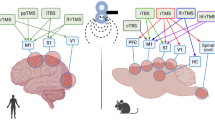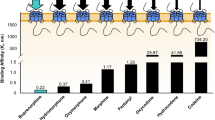Abstract
Rationale
Mu opioid receptor agonists are indispensable for the treatment of pain, but clinical use carries the inherent risk of transition from effective treatment to abuse. Abuse potential appears to increase rapidly during periods of initial opioid exposure in humans, and this increase in opioid reward during initial opioid exposure can be modeled in rats using an intracranial self-stimulation (ICSS) procedure.
Objectives
The goal of the present study was to examine temporal parameters of this phenomenon.
Methods
Adult male Sprague-Dawley rats responded for electrical brain stimulation using a frequency-rate ICSS procedure. In the first experiment, rats received daily morphine injections for 6 days, and morphine effects on ICSS were re-determined 1 day, 1 week, or 1 month after the repeated morphine treatment regimen to evaluate the persistence of enhanced opioid reward. In the second experiment, rats received six repeated morphine injections with different interdose intervals (two per day, one per day, every other day, every fourth day), and morphine effects were re-determined 1 day after the last dose to determine dosing frequencies sufficient to produce enhanced opioid reward.
Results
Results of the first experiment indicated that enhanced opioid reward was greatest 1 day after the morphine treatment regimen and completely dissipated after 4 weeks. The second experiment indicated that all dosing frequencies tested were sufficient to produce enhanced reward.
Conclusions
Taken together, these results suggest that enhancement of opioid reward after initial opioid exposure is relatively transient but can be produced by a range of different dosing frequencies.



Similar content being viewed by others
References
Altarifi AA, Negus SS (2011) Some determinants of morphine effects on intracranial self-stimulation in rats: dose, pretreatment time, repeated treatment, and rate dependence. Behav Pharmacol 22:663–673
Altarifi AA, Miller LL, Negus SS (2012) Role of mu-opioid receptor reserve and mu-agonist efficacy as determinants of the effects of mu-agonists on intracranial self-stimulation in rats. Behav Pharmacol 23:678–692
Altarifi AA, Rice KC, Negus SS (2013) Abuse-related effects of mu-opioid analgesics in an assay of intracranial self-stimulation in rats: modulation by chronic morphine exposure. Behav Pharmacol 24:459–470
Altarifi AA, Yuan Y, Zhang Y, Selley DE, Negus SS (2015) Effects of the novel, selective and low-efficacy mu opioid receptor ligand NAQ on intracranial self-stimulation in rats. Psychopharmacology 232:815–824
Altarifi AA, David B, Muchhala KH, Blough BE, Akbarali H, Negus SS (2017) Effects of acute and repeated treatment with the biased mu opioid receptor agonist TRV130 (oliceridine) on measures of antinociception, gastrointestinal function, and abuse liability in rodents. J Psychopharmacol 31:730–739
Babbini M, Gaiardi M, Bartoletti M (1975) Persistence of chronic morphine effects upon activity in rats 8 months after ceasing the treatment. Neuropharmacology 14:611–614
Bauer CT, Banks ML, Blough BE, Negus SS (2013) Use of intracranial self-stimulation to evaluate abuse-related and abuse-limiting effects of monoamine releasers in rats. Br J Pharmacol 168:850–862
Bauer CT, Banks ML, Negus SS (2014) The effect of chronic amphetamine treatment on cocaine-induced facilitation of intracranial self-stimulation in rats. Psychopharmacology 231:2461–2470
Bonano JS, Glennon RA, De Felice LJ, Banks ML, Negus SS (2014) Abuse-related and abuse-limiting effects of methcathinone and the synthetic “bath salts” cathinone analogs methylenedioxypyrovalerone (MDPV), methylone and mephedrone on intracranial self-stimulation in rats. Psychopharmacology 231:199–207
Broekkamp CL, Van den Bogaard JH, Heijnen HJ, Rops RH, Cools AR, Van Rossum JM (1976) Separation of inhibiting and stimulating effects of morphine on self-stimulation behaviour by intracerebral microinjections. Eur J Pharmacol 36:443–446
Carlezon WA Jr, Chartoff EH (2007) Intracranial self-stimulation (ICSS) in rodents to study the neurobiology of motivation. Nat Protoc 2:2987–2995
Collins FS, Koroshetz WJ, Volkow ND (2018) Helping to end addiction over the long-term: the research plan for the NIH HEAL initiative. JAMA 320:129–130
Dowell D, Haegerich TM, Chou R (2016) CDC guideline for prescribing opioids for chronic pain - United States, 2016. MMWR Recomm Rep 65:1–49
Gaiardi M, Bartoletti M, Bacchi A, Gubellini C, Costa M, Babbini M (1991) Role of repeated exposure to morphine in determining its affective properties: place and taste conditioning studies in rats. Psychopharmacology 103:183–186
Johnson AR, Banks ML, Selley DE, Negus SS (2018) Amphetamine maintenance differentially modulates effects of cocaine, methylenedioxypyrovalerone (MDPV), and methamphetamine on intracranial self-stimulation and nucleus accumbens dopamine in rats. Neuropsychopharmacology 43:1753–1762
Kornetsky C, Esposito RU (1979) Euphorigenic drugs: effects on the reward pathways of the brain. Fed Proc 38:2473–2476
Legakis LP, Negus SS (2018) Repeated morphine produces sensitization to reward and tolerance to antiallodynia in male and female rats with chemotherapy-induced neuropathy. J Pharmacol Exp Ther 365:9–19
Lett BT (1989) Repeated exposures intensify rather than diminish the rewarding effects of amphetamine, morphine, and cocaine. Psychopharmacology 98:357–362
Miller LL, Altarifi AA, Negus SS (2015) Effects of repeated morphine on intracranial self-stimulation in male rats in the absence or presence of a noxious pain stimulus. Exp Clin Psychopharmacol 23:405–414
Moerke MJ, Negus SS (2019) Role of agonist efficacy in exposure-induced enhancement of mu opioid reward in rats. Neuropharmacology 151:180–188
Negus SS, Miller LL (2014) Intracranial self-stimulation to evaluate abuse potential of drugs. Pharmacol Rev 66:869–917
Negus SS, Moerke MJ (2019) Determinants of opioid abuse potential: insights using intracranial self-stimulation. Peptides 112:23–31
Powell KR, Holtzman SG (2001) Parametric evaluation of the development of sensitization to the effects of morphine on locomotor activity. Drug Alcohol Depend 62:83–90
Rauhala P, Idanpaan-Heikkila JJ, Tuominen RK, Mannisto PT (1995) Differential disappearance of tolerance to thermal, hormonal and locomotor effects of morphine in the male rat. Eur J Pharmacol 285:69–77
Reid LD (1987) Tests involving pressing for intracranial stimulation as an early procedure for screening the likelihood of addiction of opioids and other drugs. In: Bozarth MJ (ed) Methods of assessing the reinforcing properties of abused drugs. Springer-Verlag, Berlin, pp 391–420
Riday TT, Kosofsky BE, Malanga CJ (2012) The rewarding and locomotor-sensitizing effects of repeated cocaine administration are distinct and separable in mice. Neuropharmacology 62:1858–1866
Shah A, Hayes CJ, Martin BC (2017) Characteristics of initial prescription episodes and likelihood of long-term opioid use - United States, 2006-2015. MMWR Morb Mortal Wkly Rep 66:265–269
Shippenberg TS, Heidbreder C, Lefevour A (1996) Sensitization to the conditioned rewarding effects of morphine: pharmacology and temporal characteristics. Eur J Pharmacol 299:33–39
Sim LJ, Selley DE, Dworkin SI, Childers SR (1996) Effects of chronic morphine administration on mu opioid receptor-stimulated [35S]GTPgammaS autoradiography in rat brain. J Neurosci 16:2684–2692
Spanagel R (1995) Modulation of drug-induced sensitization processes by endogenous opioid systems. Behav Brain Res 70:37–49
Timar J, Gyarmati Z, Furst Z (2005) The development of tolerance to locomotor effects of morphine and the effect of various opioid receptor antagonists in rats chronically treated with morphine. Brain Res Bull 64:417–424
Vanderschuren LJ, Tjon GH, Nestby P, Mulder AH, Schoffelmeer AN, De Vries TJ (1997) Morphine-induced long-term sensitization to the locomotor effects of morphine and amphetamine depends on the temporal pattern of the pretreatment regimen. Psychopharmacology 131:115–122
Wiebelhaus JM, Walentiny DM, Beardsley PM (2016) Effects of acute and repeated administration of oxycodone and naloxone-precipitated withdrawal on intracranial self-stimulation in rats. J Pharmacol Exp Ther 356:43–52
Wise RA (1996) Addictive drugs and brain stimulation reward. Annu Rev Neurosci 19:319–340
Zacny JP, Lichtor JL, Zaragoza JG, de Wit H (1992) Subjective and behavioral responses to intravenous fentanyl in healthy volunteers. Psychopharmacology 107:319–326
Zacny JP, Conley K, Marks S (1997) Comparing the subjective, psychomotor and physiological effects of intravenous nalbuphine and morphine in healthy volunteers. J Pharmacol Exp Ther 280:1159–1169
Acknowledgments
The authors thank Elizabeth Leggett for expert assistance and the NIH for financial support.
Funding
This study was funded by the National Institutes of Health (Grants R01NS070715 and T32DA007027).
Author information
Authors and Affiliations
Corresponding author
Ethics declarations
Conflict of interest
The authors declare that they have no conflict of interest.
Additional information
Publisher’s note
Springer Nature remains neutral with regard to jurisdictional claims in published maps and institutional affiliations.
Rights and permissions
About this article
Cite this article
Moerke, M.J., Negus, S.S. Temporal parameters of enhanced opioid reward after initial opioid exposure in rats. Psychopharmacology 238, 725–734 (2021). https://doi.org/10.1007/s00213-020-05725-3
Received:
Accepted:
Published:
Issue Date:
DOI: https://doi.org/10.1007/s00213-020-05725-3




